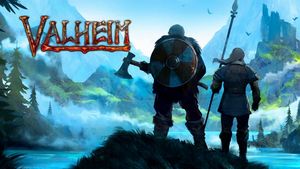Valheim: Graphics settings Valheim guide, walkthrough
Last update: 15 February 2021
From this page of the guide, you'll learn what graphics settings are available in PC version of Valheim, and their effect on smoothness and quality of displayed graphics.
Valheim has quite a lot of graphical options, and by this makes the player able to customize displayed graphics, which can be useful especially with weaker configurations.

Below we list all available graphics options of Valheim.
- Resolution: responsible for the displayed resolution of Valheim. Set it to the native resolution of your monitor (take notice of the refresh value in Hz) to get satisfactory quality of the displayed graphics. Setting lower values will cause screen blurring.
- Vegetation Quality: an option responsible for the quality of displayed vegetation;
- Particle Lights: an option that affects the quality of displayed sparks and fire so they seem more realistic;
- Draw Distance/Level of Detail: responsible for the quality of objects displayed far away. If your configuration allows it, set this option on very high. The owners of weaker graphics cards will have to choose between low and medium setting.
- Shadow Quality: the option responsible for rendering object shadows. The higher the resoultion and more shadows on screen, the more GPU memory will be required. Consider lowering shadow quality to improve smoothness on weaker computers;
- Bloom: an option that improves the quality of lighting effects. For example, when the hero is pointed towards the sun, the sunlight will light more powerfully into the monitor screen and create a blinding effect;
- SSAO: an option simulating environmental light and shadows on edges of objects, increasing the feeling of realism in the game. Unfortunately, may cause quite a loss in smoothness, especially on weaker computers;
- Sun Shafts: an effect that simulates realistic dissipating of sunlight e.g. in a moment when a very bright light source is partially covered;
- Motion Blur: an option that blurs the screen to give the game more realism. In reality, the blur lowers the visiblity, so consider this option to be off;
- Tessellation: an option that allows the display of more detailed objects, unfortunately placing a lot of strain on GPU memory. If your rig is closer to minimum than recommended configuration, turn this option off to free up some GPU memory.
- Soft Particles: an option that governs the quality of displayed effects such as fog, smoke, or dust;
- Depth of Field: an option changing the intensity of blur on objects that are out of the center of the camera. You can safely disable this option and have sharper graphics.
- Anti-Aliasing: an option responsible for smoothing edges. Unfortunately, Anti-Aliasing has some flaws, for example it blurs the screen a little bit so it doesn't seem sharp or ragged;
- Chromatic Aberration: an option that makes the game look like it was filmed by the lens of a camera, making the graphics more realistic;
- VSync: an option that lowers the displayed FPS to such values that it won't cause screen tearing and is affected by the monitor refresh rate. The performance is much better when this option is off.
